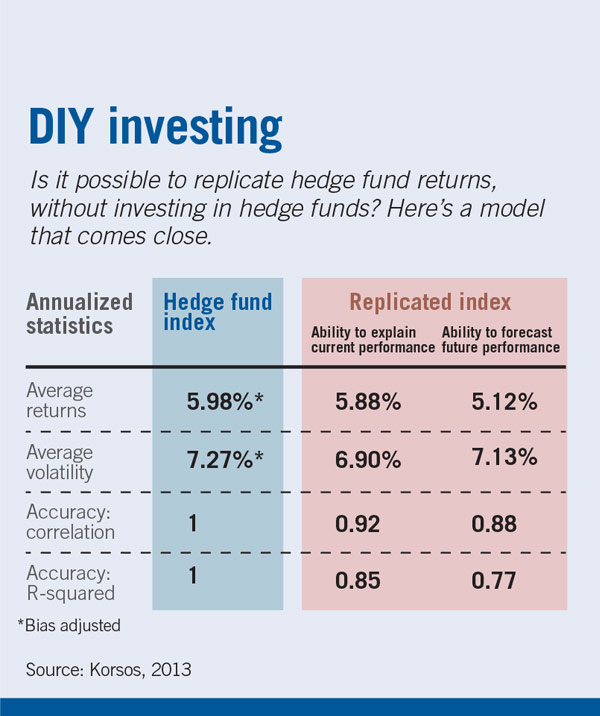
Research identifies sophisticated modeling techniques that make it possible to estimate and replicate how hedge funds invest.
- By
- June 21, 2015
- CBR - Finance

Research identifies sophisticated modeling techniques that make it possible to estimate and replicate how hedge funds invest.
Hedge funds, which held more than $2.375 trillion in capital as of March 2013, have become the investment vehicle of choice for many sophisticated investors. The funds have a reputation for outperforming other investments while offering greater protection during market downturns. But these benefits also come with a downside: hedge funds are opaque, offering very little information about what they invest in. In addition to that, investors in hedge funds often pay high fees, ante up hundreds of thousands of dollars to meet investment minimums, and commit to leaving their money in the hedge fund for months or years. Can investors get hedge fund returns without the downsides?
Research by Laszlo Korsos, who graduated from Chicago Booth this summer with a PhD in econometrics and statistics, suggests that may be achievable. Korsos, now an associate at Goldman Sachs doing quantitative research in the fixed income division, identifies sophisticated modeling techniques that make it possible to estimate and replicate how hedge funds invest. While previous efforts to do this have had limited success, Korsos’s approaches appear far more effective.
Using monthly performance data from a well-known hedge fund index, Korsos is able to infer more detailed information about investment allocation, then generate similar insights for more specific investment strategies, including long/short equity, quantitative, event driven, macro, and relative value in addition to the multistrategy composite.
Korsos tests his model, against the best models identified by earlier research, using Hedge Fund Research Fund Weighted Composite Index data from 1995 to 2012, a period that spans a variety of macroeconomic conditions and market cycles. Findings indicate that his model is the most successful, by a wide margin, at determining how hedge funds during that period invested and performed. The actual asset allocation remains unknown, but Korsos’s estimates produce performance forecasts that come closest to the performance results that were ultimately reported.
His model also considers net portfolio leverage, which none of the other models does. While most of the models produce less accurate results for hedge funds that have a greater number of holdings, Korsos’s model proves more reliable in the face of complexity and outperforms the other models by an even greater margin, on a relative basis.

For investors who want to replicate hedge fund investments, this model is especially useful when it comes to asset classes that hedge funds do not have to disclose in detail in Securities and Exchange Commission filings, such as currencies, commodities, fixed income, and all short positions. The model could help inform decisions about how and when to actively shift funds in or out of hedge fund products—for example, an investor who dislikes biotechnology stocks could choose to exit the hedge fund if the model indicates that the fund’s manager is overweighting that sector.
Moreover, in addition to providing more information about how hedge funds are invested, the model can also be used to infer their likely investment holdings in the future. If hedge fund portfolio components can be estimated without a significant time lag, they could be replicated by clone funds, allowing regular investors to put their money in hedge fund–style investment vehicles at a fraction of the cost.

Chicago Booth’s John Paul Rollert reflects on the continuing relevance of Bret Easton Ellis’s 1991 novel.
Has Capitalism Moved On from ‘American Psycho’?
Revisiting a conversation between Eugene F. Fama and Richard H. Thaler on the efficiency of financial markets.
Is the Price Right? Two Nobel Laureates Debate How Markets Work
Late payments and discriminatory behavior can echo up and down the chain.
Trade Credit Can Help the Supply Chain, or Hurt ItYour Privacy
We want to demonstrate our commitment to your privacy. Please review Chicago Booth's privacy notice, which provides information explaining how and why we collect particular information when you visit our website.